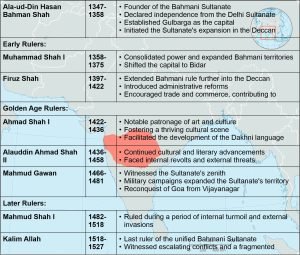19 Dec 2023 Bahmani Sultanate
This article covers “Daily Current Affairs” and the topic details “ Bahmani Sultanate”. This topic has relevance in the Art and Culture section of the UPSC CSE exam.
GS 1: Art and Culture
Why in the news?
The Karnataka High Court has instructed the authorities in the Kalaburagi district to eliminate encroachments from the historic fort of the Bahmani Sultans situated in the city.
Foundation and Territorial Expansion
- Establishment by Hasan Bahman Shah: The Bahmani Sultanate, or Bahmanid Empire, was established in 1347 by Ala-ud-Din Hasan Bahman Shah, a governor who declared independence from the Delhi Sultanate and made Gulbarga the capital.
- Territorial Expansion: The empire, under rulers like Muhammad Shah I and Firuz Shah, expanded its territories, including Gulbarga, Bidar, Bijapur, and Golconda (modern-day Hyderabad), solidifying its influence in the Deccan region.
Administration and Governance
- Feudal System: Administrative divisions included Daulatabad, Bidar, Berar, and Gulbarga, each governed by tarafdars or subedars. A decentralized feudal system empowered provincial rulers known as walis or nayaks.
- Central Administration: Centralized administrative structures managed revenue, justice, and military affairs, ensuring effective governance.
Cultural and Socio-Economic Development
- Patronage of Arts and Culture: The Bahmani rulers fostered art, literature, and architecture, contributing to the development of the distinctive Deccani culture. Notable structures included Gulbarga’s Jama Masjid, Bidar’s Rangeen Mahal, and Bijapur’s Gol Gumbaz.
- Promotion of Regional Languages: The Bahmani court supported local languages such as Dakhni and Kannada, contributing to the growth of regional literature.
- Economic Prosperity: The strategic location of the sultanate facilitated flourishing trade in horses, textiles, and spices, contributing to economic prosperity.
Religious Policies
- Religious Tolerance: The sultans pursued a policy of religious tolerance, fostering peaceful coexistence among Hindus, Muslims, Jains, and Christians.
- Promotion of Syncretic Culture: The Bahmani Sultanate’s cultural landscape reflected the syncretic blending of diverse religious traditions and practices.
Decline and Fragmentation
- Internal Strife and Dynastic Conflicts: Internal conflicts and power struggles among the nobility weakened the unity of the Bahmani Sultanate.
- Rise of Five Successor States: In 1527, the sultanate fragmented into five independent states known as the Deccan Sultanates—Ahmadnagar, Bijapur, Golconda, Berar, and Bidar—marking the end of the Bahmani Sultanate.

Fragmentation and Emergence of Deccan Sultanates:
After the military campaigns led by Krishnadeva Raya of the Vijayanagar Empire, the once-unified Bahmani Sultanate splintered into five distinct states, collectively known as the Deccan Sultanates. Each of these successor states operated independently, contributing significantly to the cultural, artistic, and political landscape of the Deccan region.
- Ahmadnagar Sultanate: Established under the rule of Ahmad Nizam Shah I.
- Bijapur Sultanate: Established by Yusuf Adil Shah.
- Golconda Sultanate: Founded by Quli Qutb Shah.
- Berar Sultanate: Ruled by Fathullah Imad-ul-Mulk.
- Bidar Sultanate: Established by Amir Barid.
Battle of Talikota (1565):
The culmination of tensions between the Deccan Sultanates and the Vijayanagar Empire resulted in the catastrophic Battle of Talikota in 1565. This pivotal conflict led to the downfall of the Vijayanagar Empire, reshaping the political dynamics of the Deccan.
Mughal Annexation:
Subsequently, the Mughal Empire, particularly under the reigns of Akbar and later Aurangzeb, extended its dominion over the Deccan Sultanates. This marked the final chapter in the Bahmani legacy, as the Mughals integrated the once-independent Deccan Sultanates into their vast empire, bringing an end to their distinct political identity.
Download Yojna daily current affairs eng med 19th Dec 2023
Q.1 Consider the following pairs:
- Ahmadnagar Sultanate : Ahmad Nizam Shah I
- Bijapur Sultanate : Quli Qutb Shah
- Golconda Sultanate : Yusuf Adil Shah
- Berar Sultanate : Amir Barid
How many of the above pairs are correctly matched?
(a) Only one
(b) Only two
(c) Only three
(d) All four
ANSWER: A
Q.2 Discuss the significant contributions of the Deccan Sultanate to the mosaic of Indian art and architecture during the medieval period.


No Comments